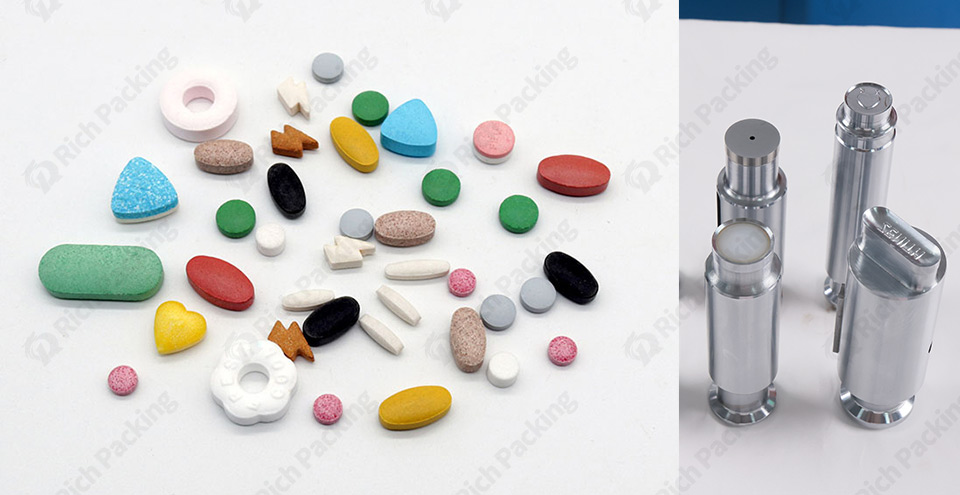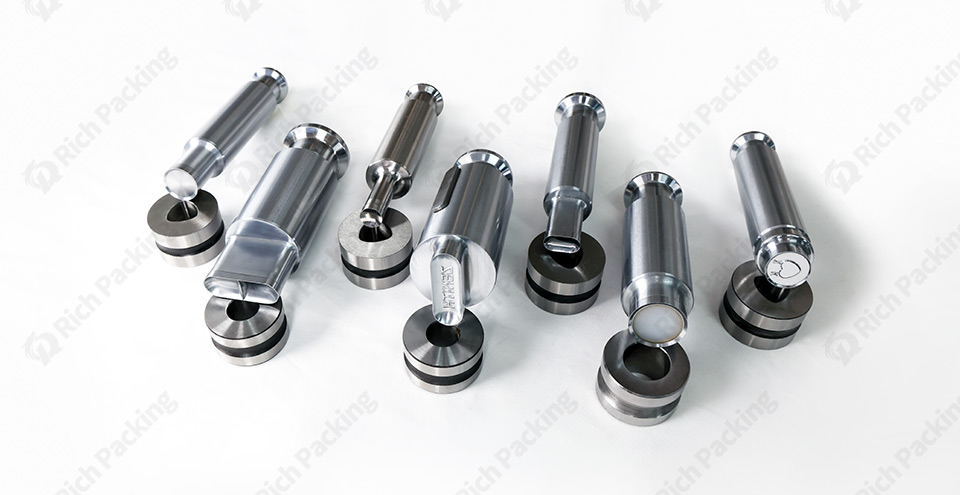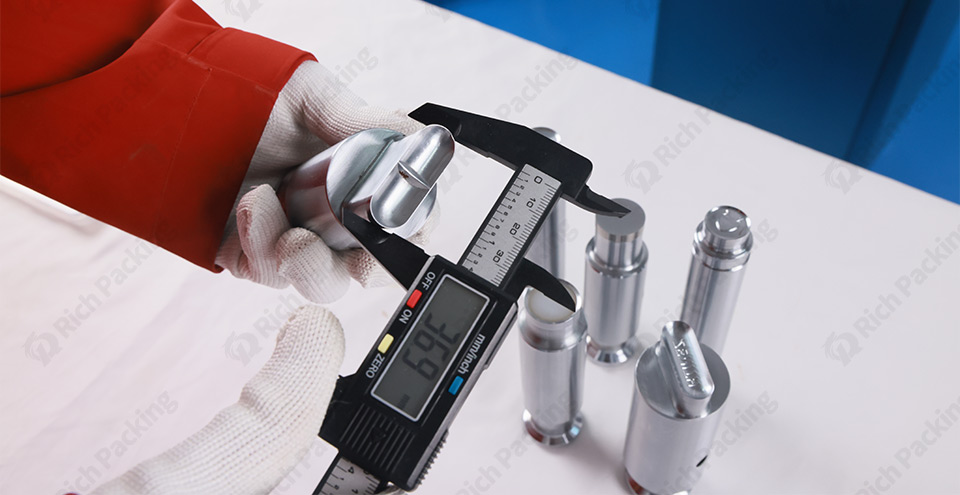Dalam industri seperti farmaseutikal, pembuatan makanan, dan pengeluaran kimia harian, penekan tablet memainkan peranan yang penting. Komponen teras a mesin penekan tablet , die, bukan sahaja asas untuk memastikan kualiti produk tetapi juga jaminan kecekapan pengeluaran. Walau bagaimanapun, prestasi penekan tablet sangat dipengaruhi oleh penyelenggaraan dan penjagaan. Prosedur penyelenggaraan yang tepat dan terperinci boleh memastikan prestasi acuan yang optimum, memanjangkan jangka hayatnya dan mengurangkan masa henti pengeluaran dengan ketara. Di bawah, kami menyediakan gambaran menyeluruh tentang struktur asas dan prinsip kerja cetakan tablet, bersama-sama dengan panduan terperinci tentang penyelenggaraan dan penjagaan cetakan profesional.

Sebelum menyelami pengetahuan penyelenggaraan dan penjagaan, adalah penting untuk mempunyai pemahaman yang jelas tentang komponen utama cetakan tablet dan fungsinya. Cetakan tablet tablet terdiri daripada beberapa bahagian penting, masing-masing memainkan peranan unik dalam proses pengeluaran.
Pertama, terdapat penebuk atas dan penebuk bawah, yang berfungsi bersama-sama dengan rongga acuan, bahagian tengah acuan, untuk memampatkan bahan menjadi tablet. Seterusnya, penyuap memastikan bahawa bahan serbuk dihantar dengan tepat ke rongga die. Semasa proses pemampatan tablet, tablet yang dikeluarkan ditolak keluar dari rongga die oleh ejector dan akhirnya dilepaskan melalui pelongsor nyahcas.
Mengenai prinsip kerja, cetakan tablet menggunakan mekanisme pemampatan fizikal berketepatan tinggi, menggunakan tekanan mekanikal untuk memampatkan bahan serbuk ke dalam tablet pepejal dalam rongga cetakan. Proses ini melibatkan aliran bahan yang kompleks dan sains ubah bentuk, yang memerlukan acuan mempunyai ketepatan tinggi dan kawalan parameter yang ketat seperti tekanan, kelajuan dan jumlah isian semasa operasi.

Dalam pengeluaran harian, cetakan tablet mungkin menghadapi pelbagai masalah. Di bawah, kami menyelidiki kegagalan biasa ini dan strategi pencegahan dan penyelesaian yang sepadan.
Mati Tersumbat
Apabila serbuk terlalu halus atau melekit, atau mengandungi kekotoran, saluran die boleh menjadi tersumbat. Dalam kes ini, hentikan mesin, bersihkan saluran die yang tersumbat, dan periksa kehausan yang disebabkan oleh penyumbatan. Butiran serbuk yang terlalu halus atau tambah bahan adunan untuk mengurangkan kelekitan, dan menapis kekotoran untuk memastikan operasi penekan tablet lancar.
Kegagalan Berkaitan Bahan
Kelembapan atau kekotoran yang berlebihan dalam suapan boleh menyebabkan tersumbat dan menjejaskan kualiti tablet. Memastikan bahan mentah kering dan bersih adalah penting untuk mengelakkan masalah tersebut.
Die Wear
Disebabkan geseran, cetakan boleh haus dari semasa ke semasa semasa penggunaan yang berpanjangan. Periksa cetakan secara kerap untuk haus dan gunakan pelincir berkualiti tinggi untuk penyelenggaraan bagi mengurangkan haus.
Deformasi Mati atau Pecah
Tekanan atau hentaman yang berlebihan boleh menyebabkan acuan berubah bentuk atau pecah. Gantikan komponen cetakan yang rosak dengan segera, laraskan parameter penekan tablet, dan periksa serbuk bahan mentah untuk mengelakkan berulang.
Keletihan Logam
Pengeluaran berulang boleh menyebabkan keletihan logam, menyebabkan keretakan atau bahkan pecah. Jalankan ujian tekanan dan ramalan jangka hayat secara berkala untuk acuan meramal dan mengawal kelesuan logam dengan berkesan.
Kegagalan Mekanikal Kerana Operasi yang Tidak Betul
Tabiat operasi yang tidak betul, seperti menggunakan tekanan atau kelajuan yang berlebihan, boleh merosakkan acuan. Latihan tetap dan penetapan parameter mekanikal yang tepat adalah penting untuk mencegah isu tersebut.
Pembersihan Berkala
Pembersihan selepas setiap pengeluaran adalah langkah pertama dalam mencegah kegagalan cetakan. Gunakan berus lembut dan agen pembersih yang sesuai untuk mengeluarkan habuk dan sisa. Elakkan menggunakan berus keras untuk mengelakkan kerosakan pada permukaan cetakan.
Pemeriksaan dan Penggantian
Periksa cetakan dengan teliti untuk mengesan keretakan keletihan atau haus yang ketara dan gantikan komponen mengikut keperluan. Penggantian tepat pada masanya boleh menghalang isu kecil daripada bertukar menjadi kegagalan besar.
Pelinciran
Selalu pelincir bahagian yang bergerak pada acuan untuk mengurangkan haba dan haus akibat geseran. Pilih pelincir yang sesuai seperti yang disyorkan oleh pengilang.
Penentukuran
Tekanan seragam dan kelajuan yang betul adalah penting untuk memaksimumkan jangka hayat die. Kalibrasi parameter penekan tablet dengan tepat setiap kali dadu diganti atau produk baharu dihasilkan.
Elakkan Tempoh Lama Kerja Berintensiti Tinggi
Kerja intensiti tinggi yang berterusan mempercepatkan kehausan dan kerosakan die. Susun jadual kerja dengan munasabah untuk mengelakkan operasi beban tinggi yang berpanjangan.
Latihan Operator
Operator harus menerima latihan profesional untuk memahami prinsip kerja dan titik penyelenggaraan cetakan tablet. Ikuti prosedur semasa operasi untuk mengelakkan kerosakan akibat pengendalian yang tidak betul.
Rekod Penyelenggaraan Terperinci
Mengekalkan rekod terperinci setiap sesi penyelenggaraan dan penjagaan. Ini membantu menjejaki keadaan die dan meramalkan potensi isu.
Melaksanakan Latihan Berkala
Menjalankan sesi latihan yang kerap untuk pengendali untuk memastikan mereka dikemas kini tentang teknik penyelenggaraan dan prosedur operasi keselamatan terkini.
Dengan kemajuan pembuatan pintar, penyelenggaraan cetakan tablet juga menjadi lebih pintar dan automatik. Penyelesaian inovatif berikut menyerlahkan trend ini:
Sistem Pemantauan Jauh
Dengan memasang penderia dan peranti yang disambungkan, juruteknik boleh memantau status kerja alat penekan tablet dalam masa nyata, termasuk suhu, tekanan dan kelajuan. Ini membolehkan diagnosis kerosakan jauh dan panduan penyelenggaraan.
Perisian Penyelenggaraan Ramalan
Menggunakan data besar dan algoritma pembelajaran mesin, perisian penyelenggaraan ramalan boleh meramalkan keperluan penyelenggaraan dan masa kegagalan dengan tepat untuk mesin penekan tablet, membantu mencipta pelan penyelenggaraan yang lebih berkesan yang memaksimumkan kecekapan pengeluaran dan mengurangkan kos penyelenggaraan.
Sistem Pembersihan dan Pelinciran Autonomi
Penekan tablet termaju dilengkapi dengan sistem pembersihan dan pelinciran automatik yang boleh melakukan pembersihan dan pelinciran tetap pada cetakan tanpa mengganggu pengeluaran. Ini meningkatkan kecekapan dan ketepatan kerja penyelenggaraan.

Penyelenggaraan dan penjagaan cetakan tablet adalah penting untuk memastikan kesinambungan pengeluaran dan kualiti produk. Dengan mengguna pakai teknologi canggih, penyelesaian penyelenggaraan yang inovatif dan teknik praktikal, kami boleh meningkatkan kecekapan penyelenggaraan dengan ketara, memanjangkan jangka hayat die dan memastikan pengeluaran yang stabil dan cekap. Pada masa hadapan, dengan kemajuan teknologi yang berterusan dan tahap kecerdasan yang semakin meningkat, penyelenggaraan cetakan tablet akan menjadi lebih saintifik dan diperhalusi, membantu setiap langkah pengeluaran mencapai transformasi yang berkualiti tinggi dan cekap.
Kami berharap kandungan di atas dapat membantu anda. Jika anda mempunyai sebarang soalan atau keperluan teknikal lanjut, sila hubungi hubungi kami .